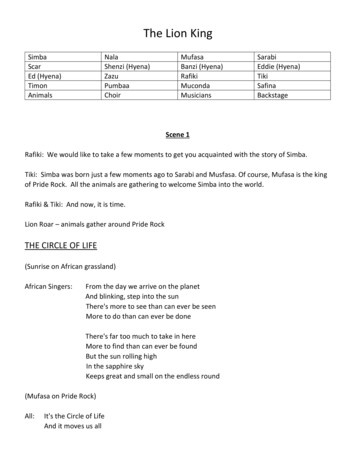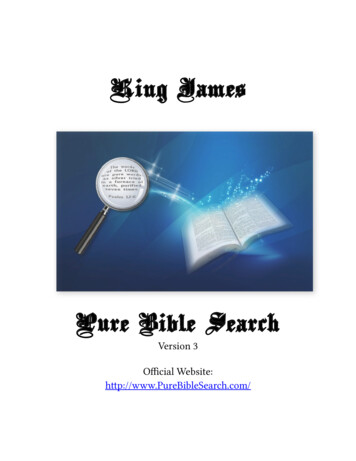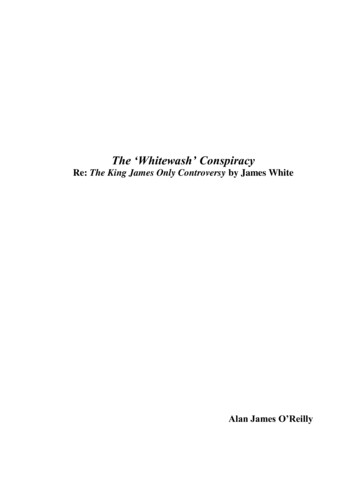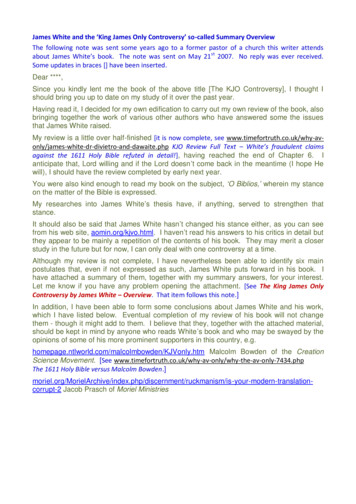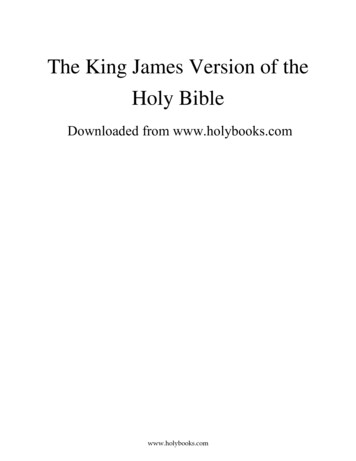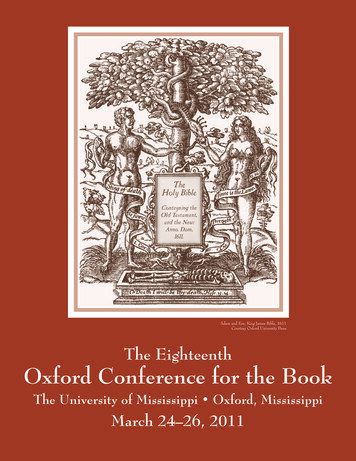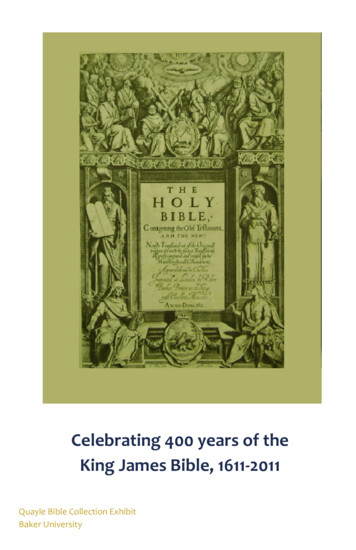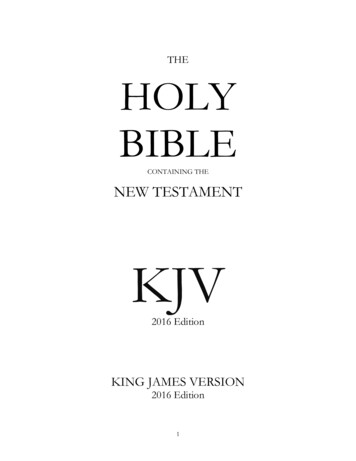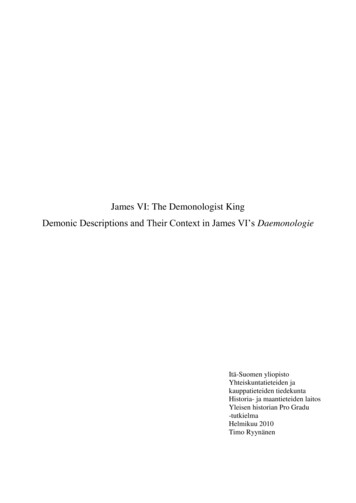
Transcription
James VI: The Demonologist KingDemonic Descriptions and Their Context in James VI’s DaemonologieItä-Suomen yliopistoYhteiskuntatieteiden jakauppatieteiden tiedekuntaHistoria- ja maantieteiden laitosYleisen historian Pro Gradu-tutkielmaHelmikuu 2010Timo Ryynänen
Contents1. Introduction. 21.1 Scotland and Its Religious Situation at the End of the 16th Century . 21.2 Demonology and King James’ Background as a Demonologist . 41.3 The Research Subject, Source and Methdods . 71.4 Previous Studies . 82. The Influence of Classical Works and Other Demonologists. 102.1 The Bible as a Source for James . 102.2 The Bible and the Demonic Possession of Dead Bodies. 112.3 Classic Demonic Possession and the Bible . 122.4 Greek and Roman Influences in the Third Book of Daemonologie . 142.5 Other Demonologists as Sources for James . 153. The Religious Reformation’s Effects on James’ Demonology . 173.1 The Reformation. 173.2 Protection against demons . 173.3 Demonic Possession After the Reformation . 203.4 Fairies and the Reformation . 223.5 Concerning Werewolves. 233.6 Ghosts in James’ Demonology? . 253.7 King James VI: A Reformed Demonologist? . 274. The Politics of Demonology . 284.1 Reformation and the Political Situation . 284.2 Demonology as a Weapon against Political Enemies? . 294.3 Bothwell as James’ Personal Satan . 314.4 King from the Divine Right . 335. Conclusions. 36The Source and References . 39
1. Introduction1.1 Scotland and Its Religious Situation at the End of the 16th CenturyDuring the 16th century the kingdom of Scotland went through various major changesconcerning both its religion and politics. These changes were not separate from each other,but rather two aspects of the same administrative framework1. This century saw Scotland gothrough a religious Reformation, which at the same time meant changes in the kingdom’sexternal and internal politics. Before the 16th century Scotland had long been an ally ofFrance, and opposed to England. By the beginning of the 17th century it had become a closeally of England, with both states ruled by the same king.2In the beginning of the 16th century Scotland was still officially Catholic. At this time itssouthern neighbor England had already began its journey towards Reformation during the ruleof King Henry VIII3. In Scotland the spread of the Reformation was slowed down by KingJames V, who was more interested in asserting his personal rule and did not see religiousReformation as something that would further his aims. However, his death in 1542 changedthings considerably. James was succeeded by his daughter Mary Stuart, now usually knownas Mary Queen of Scots. The political importance of this was quite significant. The Englishking Henry wanted to marry his son Edward to Mary in order to secure England’s northernborder, while England’s enemies, particularly France, wanted to prevent this fromhappening.4 So in this regard Scotland was still time the same it had been for centuries: Asmall part of the power struggle between European superpowers.At first it seemed that England would prevail. The Scottish regent Arran was openlysympathetic towards the Reformation and an alliance with England. This did not last for long,and soon pressure from the church and the nobles forced him to revise his view. This was notwell received by King Henry VIII who launched a series of military offensives against1Lee 1990, 2.Mason 2005, 107.3Schama 2003, 253-254.4Mason 2005, 119-120.22
Scotland. A change came when Henry died before managing to subjugate Scotland. The ruleof England was taken over by Edward Seymour, who ruled instead of his nephew, the nineyear old King Edward VI.5The religious situation in Scotland at the end of the 16th century was turbulent. The religiousReformation had begun in the 1560’s and was still not completely over6. The country had alsosuffered from a religious civil war between 1567 and 1573. The war was fought between theCatholic supporters of Mary Queen of Scots and the Protestant nobles of Scotland, and thedisorder following it still had not completely calmed down in 1578 when Mary’s son Jamesascended the throne and became King James VI of Scotland7.As the Reformation went on the Catholic Church continued to lose its power in Scotland. TheReformed Church that arose to replace it was strongly influenced by the teachings of JohnCalvin, and by a Scottish clergyman named John Knox. This new Presbyterian Churchbecame known as the Kirk.8 The shift in religious power naturally influenced everythingconnected to religion. The Reformation in Scotland during the 16th century was not only aboutthe rearrangement of the church, but also about the relations between the church and the state.The Presbyterian Church declared that it only answered to God, not any secular ruler. This ofcourse was not well received by the worldly rulers of Scotland. The declaration was includedin The Second Book of Disciple, published in 1578 by the Kirk, which outlined its new policy.The answer from the state came in 1584 when King James enacted the “Black Acts”, acollection of statutes that declared that the king’s power over all men was absolute. The Actsalso condemned the presbyteries and perhaps surprisingly increased the power ofCatholicism.9In the beginning of the 1590’s the Kirk and the crown were still at odds. However, theirrelations had improved a bit from the previous decade, and in 1587 they had agreed on atemporary truce. During the 1590’s a common enemy for the Kirk and the king arose:Witchcraft. The truce continued through the great witch hunts until 1596, when King Jamesmanaged to assert his control over the Kirk and effectually become the absolute ruler of5Mason 2005, 122-123.Normand & Roberts 2000, 72.7Normand & Roberts 2000, 17-18.8Normand & Roberts 2000, 72-74.9Normand & Roberts 2000, 74.63
Scotland.10 During these tumultuous years James fought against both the Kirk and the Scottishnobles, and finally emerged victorious. He used many means to achieve this, one of whichwas demonology, which is the subject I will concentrate on in this thesis. Uniquely amongrenaissance monarchs, King James was somewhat of a demonologist himself. DuringScotland’s great witch trials of the 1590’s, he wrote a demonological treatise in which hedetails his view of demonology and how it connects to religious and royal power.1.2 Demonology and King James’ Background as a DemonologistWhat was demonology? Classically, it has been defined as study of evil spirits, demons, or thetheology of evil11. In my opinion the most descriptive definition is the one presented byAnkarloo, Clark and Monter: Demonology was the literature of witchcraft12. Studyingdemons and the Devil, describing their appearance, behavior and how to repel them were all alarge part of it, but in the end demonology of the early modern Europe should not be removedfrom its context: The witch trials and hunts which it served to justify. A need for this kind ofjustification arose from the fact that witches were attributed many powers, some of whichwere quite powerful and very unnatural. Witches were thought to have no magical powers oftheir own, but to have received their powers from demons13. Therefore demonology wasneeded as way to justify the existence of such magic, and the witch trials that ensued14.Christian demonology is usually said to have formally begun with the infamous MalleusMaleficarum in 148615. By the time King James VI begun his career as a demonologist healready had more than one hundred years of literary tradition to support him. Demonologyitself was a complex subject. It was not something people across social classes were interestedin, but it was rather limited to the upper classes and the elite. While the common people heldon to hundreds, or even thousands of years old folk beliefs of evil spirits viewed through the10Normand & Roberts 2000, 76.Pearl 1999, 25.12Ankarloo, Clark & Monter 2002, 122.13Goodare 2008, 27.14Ankarloo, Clark & Monter 2002, 123.15Boureau 2006, 8.114
lens of Christianity, the social elite began to construct their own system of beliefs concerningthe Devil and his agents.16Christian demonology in the 16th century was not a uniform field of study. Most of all, it wasdivided by the Reformation, which abandoned many of the old Catholic teachings regardingdemonology. In Scotland for example, Catholicism and demonic magic were even seen asequal evils17. Religion was not alone in dividing opinions. Political agendas were a part ofdemonology as much as the religious ones, and could easily influence demonologists to colortheir views18.Some reformists, such as the English scholar Reginald Scot, even believed that things likedemonology belonged to Catholicism and had no place whatsoever in the reformed religion19.However, this was not the general opinion of the time, and demonology would come to play amajor part in the internal politics of Scotland during the end of the century. One, and perhapsthe most important one, of the key players in these events was King James VI himself.King James VI became interested in demonology quite early in his life. He was only in histwenties when he wrote his demonological treatise, Daemonologie, In Forme of a Dialogue,Divided into three Bookes. I shall from now on refer to the book simply as Daemonologie.According to the traditional view James’ main influence in becoming a demonologist was hisjourney to Denmark to meet his bride in 1589-1590. The records of this journey tell us that hemet the famous Danish demonologist Niels Hemmingsen during his stay in Denmark20.Several scholars have suggested that this meeting was what prompted James to take a deeperinterest in demonology, and introduced him to the continental demonological idea of ademonic pact. Probably the most prominent historian to advocate this view was Stuart Clarkin his famous essay “King James’ Daemonologie: Witchcraft and Kingship” in 1977. Clarkargues that the idea of a demonic pact was unknown in Scotland before James introduced it,and that it was of key importance to the witch trials that followed in the 1590s21. Even morerecent studies have supported this view22.16Pearl 1999, 1.Goodare 2005, 48.18Ankarloo, Clark & Monter 2002, 138.19Clark 2005, 526.20Normand & Roberts 2000, 330.21Clark 1977, 157.22Henderson & Cowan 2001, 122; Croft 2002, 26.175
This traditional view has been challenged in the recent years by the foremost experts of thehistory of Scottish witch trials and King James. Julian Goodare believes that although the ideaof a demonic pact was not explicitly stated in the Scottish witchcraft act, it was most likelyknown in Scotland before James’ journey to Denmark23. Jenny Wormald supports this view,and also states that James was not responsible for introducing the idea of a demonic pact toScotland24. Lawrence Normand and Gareth Roberts point out that it is not even certainwhether James and Hemmingsen even discussed demonology during their meeting25.In the Christian religion demonology is a part of theology, and most of King James VI’sdemonical descriptions indeed have their roots in religion. On the other hand, in 16th centuryScotland the church and the state were not separate entities, but overlapped each other invarious cases. Religion was involved in nearly all governmental issues, and during James’reign the state took more and more interest in interfering with religious questions and issues.26Therefore it is not surprising that Daemonologie was not merely a standard demonologicaltreatise in the full sense of the word. Of course at first glance it would seem very much so,and has been described as thus by various scholars27. If it had been written by anyone else,this might well be the case. James’ unique position as the only renaissance monarch to studyand write about demonology is what makes the book more than meets the eye. It was not onlyinfluenced by the Reformation, but also by the political situation James had to deal withduring the 1590s. In this respect some scholars have even claimed that Daemonologie couldbe seen as James’ most important literary work28.My interest here is whether James’ descriptions of demons were affected by the politicalclimate of the 1590s in which he lived and wrote his book. Daemonologie as a whole mayhave been somewhat politically motivated, but one should bear in mind that two thirds of it ismainly concerned with witchcraft, and the final third that deals in the descriptions of demonsand their abilities is somewhat different. And as previously stated, the politics of this timeshould not be discussed as separate from religion, at least not when their context is that of23Goodare 2005, 58-59.Wormald 2000, 174.25Normand & Roberts 2000, 330.26Goodare 1999, 173.27Clark 1977, 156; Normand & Roberts 2000, 331; Ankarloo, Clark & Monter 2002, 127.28Wormald 2000, 169.246
demonology. This is the reason why I examined the effects of religion, meaning mainly theReformation and the differences between Catholic and Reformed demonology, before goinginto the politics. To understand the political context of Daemonologie one must firstunderstand the religious situation overlapping it.1.3 The Research Subject, Source and MethdodsThis thesis is the second part of my master’s thesis. The first part consists of a script for atelevision documentary “James VI of Scotland: The Demonologist King”. The documentarytells about King James as a demonologist, and how he used demonology to achieve hispolitical goals. This thesis is a more thoroughly scientific addition to the documentary, anddeals with James’ demonology on a closer level. I will specifically concentrate on James’notion of demons and the way he describes them in his book Daemonologie.Because of his unique position as both a king and a demonologist most everything inDaemonologie can be seen as having some form of political and religious meaning. The bookis divided into three parts. The first one deals with magic, the second with witches and thethird with demons and other spirits. I will analyze the third part and try to uncover the reasonsbehind James thinking.While the third book of Daemonologie mainly consists of James’ descriptions of demons, italso includes a short chapter on the punishment of witches, which I will also analyze. It wouldnot be prudent to leave this chapter out, because it more or less summarizes the whole bookand what James was trying to achieve by writing it. The specific question I will try to answerhere is why did James write the third book of Daemonologie the way he did? On a morespecific level I will look at what his motives were and what kind of religious, political andother reasons can be found behind his reasoning.The reason I chose this particular subject for my thesis is twofold. Firstly, it ties well with mydocumentary script, providing a narrower but at the same time deeper look into James VI’sdemonology. Secondly, the third part of James’ book is the one that has drawn least interest inprevious studies. The focus on studying James’ demonology has usually been on its witchcraft7
aspect. I do not deny that it is an important aspect, but at the same time I feel thatconcentrating on James’ descriptions of demons will provide a fresh point of view.My source for this thesis is naturally King James’ book Daemonologie, In Forme of aDialogue, Divided into three Bookes. There are several editions of the book, printed usuallyin either Scotland on England. I will use the edition printed in Edinburgh in 1597 by RobertWalde-grave, printer to King James. My copy of the book is a scanned version of a physicalcopy located in the Henry E. Huntington Library and Art Gallery.The details concerning the writing and publication of the book are a bit unclear. Most likelyJames wrote the book during the great witch hunts of 1590’s29. The reasons why he wrote itare also a matter of speculation, in which I will concentrate more thoroughly later in thisthesis. One of the most popular and straightforward theories is that James wroteDaemonologie because he believed that there was a conspiracy of witches aimed at killinghim, and that he wanted to counter the ideas of skeptics such as Reginald Scot30. Jameshimself states in the introduction to Daemonologie that his motive for writing it is the will toconvince people that witches are real, and that they must be fought and punished31.My research method for this thesis is mainly a form of discourse analysis. I will concentrateon the relation between the text in the third book of Daemonologie and the religious andpolitical contexts linked to it. I chose this method because it is the best way to try andunderstand the context present in James’ writings. He did not of course explain why he wrotewhat he wrote, and therefore to understand the meaning behind his demonology, one mustread the text analytically and try to interpret the meaning underlying the words.1.4 Previous StudiesJames VI’s Daemonologie has been a popular choice of study amongst historians. The mainreason for this is probably the fact that it is the only demonological book written by a29Normand & Roberts 2000, 327.Robbins 1965, 277.31James Stuart 1597, 3.308
renaissance monarch, and thus provides a unique perspective32. Most of the studiesconcentrate specifically on James’ opinions on witchcraft, and focus on the first and thesecond part of the book. Especially the king’s connection to the Scottish witch trials has beena popular choice of study.When looking for the most comprehensive analysis of King James VI’s demonologyWitchcraft in Early Modern Scotland. James VI’s Demonology and the North BerwickWitches (2000), written by Lawrence Normand and Gareth Roberts is a strong choice. Itanalyzes James’ demonology thoroughly, in connection with witchcraft, politics and religion.The book also contains a copy of Daemonologie, complete with explanations for terms usedin it.Studies concerning Daemonologie and King James’ involvement in the witch-hunts diverge alot when it comes to their findings. To provide an example, the question about the importanceof the formation of the Scottish state to the witch-hunts has prompted various opposing views.Some, such as Brian P. Levack, claim that the state formation and the witch-hunts occurredmainly on different socio-economic levels: the latter amongst the people and the formeramongst the elite33. Others, including Christina Larner, have on the other hand argued that theprocess of state formation was crucial to the witch-hunts and trials34.The dating of Daemonologie has been an important and interesting question in this field ofstudy. Traditionally it has been argued that Daemonologie was written between 1591 and1597. For example, Normand and Roberts have pointed out that some passages in the secondbook of Daemonologie correspond very closely to the records we have from the witch trials of1591, which could indicate that they were still fresh in James’ mind when he was writing thebook35. This view has been challenged by Jenny Wormald, who argues that the style of thebook indicates that it was written in a hurry, as James himself says in the preface, and couldnot have been begun in 1591 but years later36. Julian Goodare has presented an idea that32Normand & Roberts 2000, 331.Sharpe 2002, 188.34Sharpe 2002, 191.35Normand & Roberts 2000, 327-328.36Wormald 2000, 179.339
somewhat merges the two viewpoints. He argues that Daemonologie was written in responseto the witch trials of 1591, but published as a response to the trials of 1597.37James’ involvement in the witch trials which Daemonologie was seen as a response to hasalso been questioned in the recent years. In the earlier studies his involvement was credited asmuch more important as it is today, mainly thanks to Jenny Wormald’s research concerningthe subject38. Wormald has, for example, convincingly stated that James was not behind thewitch trials of 1591, even though there was claimed to be a witches’ conspiracy against him39.She goes so far as to claim that Daemonologie indicates that James had become skepticaltowards witchcraft by the time the book was published, but this view lacks substantialevidence40. Still, there are other scholars who have supported this theory. Pauline Croft arguesthat James’ interest in demonology was mainly political, and that since by 1597 his majorpolitical enemies had been neutralized, he had no further need for it.41 The fact that James stillwanted to be personally involved in the interrogations of those accused of witchcraft in 1597,speaks against this view42.2. The Influence of Classical Works and Other Demonologists2.1 The Bible as a Source for JamesWhen it comes to describing the various types of demons in Daemonologie’s third book, theBible was probably the most important source for King James VI. Other scholars haveconcluded that this is also true concerning the whole book43. James derives the very existenceof these creatures, and their ability to appear to humans, from the Bible44. Since theReformation abandoned most of the teachings of the Catholic Church, the Bible remained the37Goodare 2002, 63.Wormald 2000, 170.39Wormald 2000, 171-172.40Goodare 2002, 64-65.41Croft 2003, 27.42Goodare 2002, 67.43Normand & Roberts 2000, 329.44James Stuart 1597, 58.3810
only truly reliable source for James. This is especially true when considering that the postReformation church in Scotland was very much Calvinistic at the time. The 16th centuryCalvinists saw the Bible as the only certain means of knowing anything about God45.2.2 The Bible and the Demonic Possession of Dead BodiesIn the third book of Daemonologie James divides demons into four groups. His first categoryof demons was the spirits that trouble, which means to possess or haunt certain houses orother places. In describing the demons of this type James considers the way in which they canenter into houses:“They will choose the passage for their entresse according to the forme that they are in atthat time . For if they have assumed a deade body, whereinto they lodge themselves, theycan easely inough open without dinne anie Doore or Window, and enter in thereat.”46James is thinking that this reasoning might incur the question of why God permits demons touse dead bodies in this fashion. After all, the bodies used in such a way may have belonged tovery righteous and pious people. The question is significant not only from the viewpoint ofshowing respect towards the dead, but also from a biblical view. According to Normand &Roberts “Christians believe that the bodies of the dead will be reconstituted at the Day ofJudgement and then, joined once more with the soul, be assigned to their eternal location toheaven or hell.”47. This question was raised by the Bible and was apparently a very real issuefor James, for he goes to great lengths to justify his view. According to him the dead are notdefiled if their bodies are used in this way, because their souls are absent at the time48. Thisview is also very biblical: the body may be unclean and sinful, but the soul can be saved.For James using dead bodies is the only way through which Satan can impersonate, or havehis demons impersonate, righteous people. Later in Daemonologie, book III, he discussesbriefly the biblical case of the witch of Endor, according to which a witch helped Saul contactthe dead prophet Samuel. James asks if this does not mean that Samuel himself was wicked,45Todd 2003, 24.James Stuart 1579, 58-59.47Normand & Roberts 406.48James Stuart 1597, 59.4611
because he could appear like this, but concludes that after they are dead even good people canbe used by the Devil in this fashion, be it through directly possessing their dead bodies orcreating an illusion that looks like them.49This view is important to understanding James’ thoughts on the outward appearance ofdemons. He does not describe them as terrifying-looking monsters, but rather as insubstantialspirits, that can manipulate the world either as such, or by possessing dead or living humans.Possessing dead bodies and creating illusions that look like such are clearly a key piece of hisdescriptions. The reason why James includes both possessing real dead bodies and creatingillusions of dead people into same context probably derives from the need to account forsightings of dead people who have been dead long enough for their bodies to startdecomposing.One of the ways demons can use the appearance of dead people in James’ demonology is toappear to the friends of the deceased and to fool them into thinking that the demon is actuallytheir friend50. These appearances fall under the category of illusions, because demons don’tdirectly possess the body of the dead person. These kinds of accounts show an inclinationtowards the mixing of the traditional ghost stories and demonic occurrences, which increasedsignificantly after the Reformation51. I shall discuss these more thoroughly in the chapterdealing with the effects of the Reformation.2.3 Classic Demonic Possession and the BibleDemonic possession was and is probably the most classical example of demonic influence.James devotes an entire chapter to it in the third book of Daemonologie, and, like in manyother cases, finds his inspiration and evidence from the Bible. Demonic possession was acommon diagnose during the early modern period, and thus it is not surprising that Jamestakes an interest in it. He had met people who were claimed to be possessed, so there was also49James Stuart 1597, 79.James Stuart 1597, 60-61.51Goodare 2008, 32.5012
most likely a personal interest52. It is interesting that James does not even consider any nonmystical reasons for possession, like he does later in the case of werewolves53.James states that there are three clear symptoms of demonic possession: Preternaturalstrength, swelling and hardening of the stomach and chest of the possessed, and finallyspeaking in multiple languages which the possessed normally would not understand54. Atleast the first of these symptoms is straight from the Bible. The possessed, or demoniacs asthey were called, were known for their immense strength.55 James also includes a special casefrom the Bible where the possessed cannot speak in languages, or at all. He says thatsometimes the demons may be blind and dumb, and cites the Bible for an example.56James’ generous use of the Bible in his demonic descriptions strongly indicates his Reformedtendencies. Also, a sense of Christian dualism is strongly present. In the very beginning of thethird book, James mentions that“But generally I must for-warne you of one thing before I enter in this purpose: that is,that although in my discourseing of them, I devyde them in divers kindes, yee mustnotwithstanding there of note my Phrase of speaking in that: For doubtleslie they are ineffect, but all one kinde of spirites, who for abusing the more of mankinde, takes on thesesundrie shapes, and uses diverse forms of out-ward actions, as if some were of naturebetter then other.”57The spirits, meaning demons, are according to this view effectively of just one kind. And so istheir master, the Devil, who only uses multiple names and forms to further deceive witchesand presumably other humans as well58. This means that in James’ demonology there arebasically only two types of evil beings: Satan the Antichrist and the evil spirits serving him,called demons. Here we can clearly see the dualism: Satan is God’s antithesis, and demonsare angels’ counterparts.52Normand & Roberts 2000, 416.James Stuart 1597, 61.54James Stuart 1597, 70-71.55Normand & Roberts 2000, 416.56James Stuart 1597, 71.57James Stuart 1597,57.58James Stuart
1.2 Demonology and King James’ Background as a Demonologist What was demonology? Classically, it has been defined as study of evil spirits, demons, or the theology of evil11. In my opinion the most descriptive definition is the one presented by Ankarloo, Clark and Monter: Demonol
